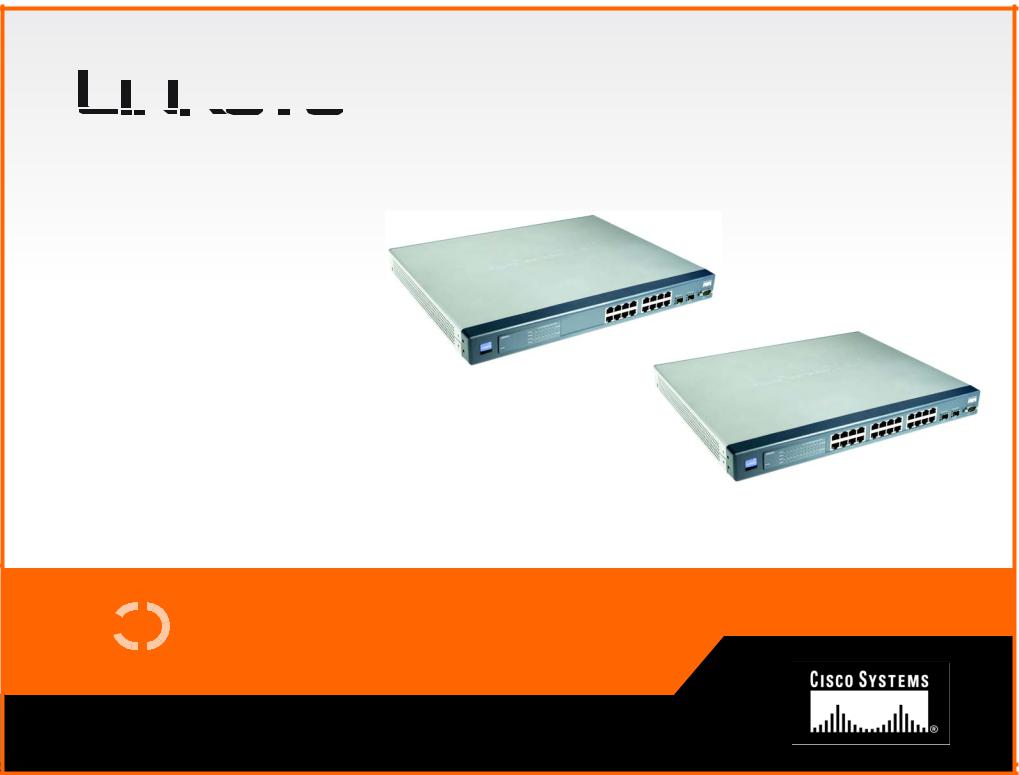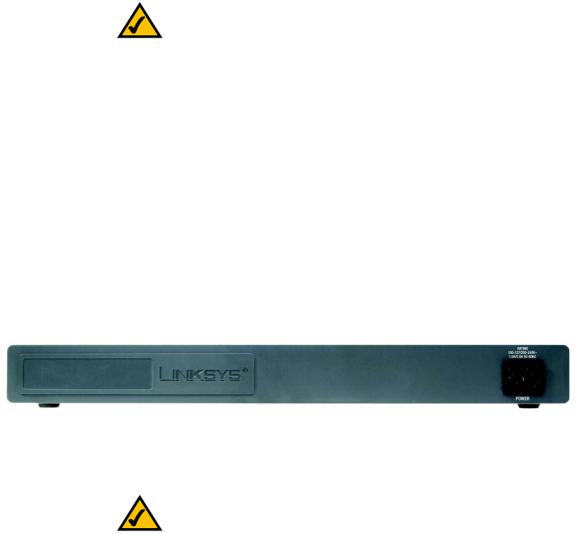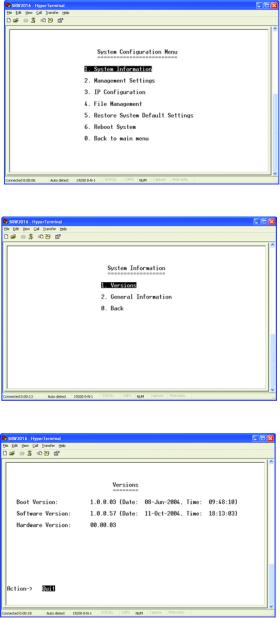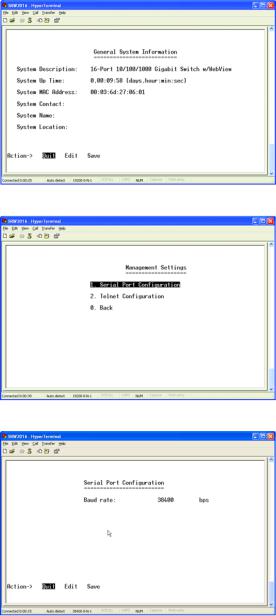Linksys SRW2016 User Manual



 ®
®
A Division of Cisco Systems, Inc.
16or 24-Port 10/100/1000 Gigabit Switch
 WIRED
WIRED
|
with WebView |
User Guide |
|
Model No. SRW2016 or SRW2024

16or 24-Port 10/100/1000 Gigabit Switch with WebView
Copyright and Trademarks
Specifications are subject to change without notice. Linksys is a registered trademark or trademark of Cisco Systems, Inc. and/or its affiliates in the U.S. and certain other countries. Copyright © 2005 Cisco Systems, Inc. All rights reserved. Other brands and product names are trademarks or registered trademarks of their respective holders.
WARNING: This product contains chemicals, including lead, known to the State of California to cause cancer, and birth defects or other reproductive harm. Wash hands after handling.
How to Use this Guide
Your guide to the 16or 24-Port 10/100/1000 Gigabit Switch with WebView has been designed to make understanding networking with the switch easier than ever. Look for the following items when reading this User Guide:
This checkmark means there is a note of interest and is something you should pay special attention to while using the Switch.
This exclamation point means there is a caution or warning and is something that could damage your property or the Switch.
This question mark provides you with a reminder about something you might need to do while using the Switch.
In addition to these symbols, there are definitions for technical terms that are presented like this: word: definition.
Also, each figure (diagram, screenshot, or other image) is provided with a figure number and description, like this:
Figure numbers and descriptions can also be found in the “List of Figures” section.
SRW2016_SRW2024-UG-50429C JL
16or 24-Port 10/100/1000 Gigabit Switch with WebView
Table of Contents
Chapter 1: Introduction |
1 |
Welcome |
1 |
What’s in this User Guide? |
2 |
Chapter 2: Getting to Know the Switch |
3 |
Overview |
3 |
The Front Panel |
3 |
The Back Panel |
4 |
Chapter 3: Connecting the Switch |
5 |
Overview |
5 |
Before You Install the Switch... |
6 |
Placement Options |
6 |
Connecting the Switch |
7 |
Chapter 4: Using the Console Interface for Configuration |
9 |
Overview |
9 |
Configuring the HyperTerminal Application |
9 |
Configuring the Switch through the Console Interface |
10 |
Chapter 5: Using the Web-based Utility for Configuration |
18 |
Overview |
18 |
Accessing the Web-based Utility |
18 |
Sys. Info. (System Information) Tab - System Description |
18 |
Sys. Info. (System Information) Tab - System Mode |
19 |
Sys. Info. (System Information) Tab - Forwarding Database |
19 |
Sys. Info. (System Information) Tab - Time Synchronization |
20 |
IP Conf. (Configuration) Tab - IP Addr. (Address) |
21 |
Switch Conf. (Configuration) Tab - Interface Conf. (Configuration) |
21 |
Switch Conf. (Configuration) Tab - VLAN |
24 |
Switch Conf. (Configuration) Tab - VLAN Port |
24 |
Switch Conf. (Configuration) Tab - LA Conf. (Configuration) |
25 |
Switch Conf. (Configuration) Tab - Port Mirroring |
26 |
Switch Conf. (Configuration) Tab - LACP |
26 |
QoS Tab - CoS Settings |
27 |
QoS Tab - Queue Settings |
27 |
16or 24-Port 10/100/1000 Gigabit Switch with WebView |
|
QoS Tab - CoS to Queue |
28 |
Security Tab - ACL |
28 |
Security Tab - 802.1x Users |
29 |
Security Tab - 802.1x Port Conf. (Configuration) |
29 |
Security Tab - Management Conf. (Configuration) |
31 |
Security Tab - RADIUS Server |
31 |
Security Tab - TACACS Server |
33 |
Security Tab - Storm Control |
34 |
Security Tab - Authenticated Users |
35 |
Security Tab - System Password |
35 |
SNTP Tab - Global Settings |
35 |
SNTP Tab - Authentication |
36 |
SNTP Tab - Servers |
37 |
SNTP Tab - Interface Settings |
38 |
Statistics Tab - Interface Statistics |
39 |
Statistics Tab - Etherlike Statistics |
40 |
Statistics Tab - RMON Statistics |
41 |
Statistics Tab - RMON History Control |
42 |
Statistics Tab - RMON History Log |
43 |
Statistics Tab - RMON Alarms |
44 |
Statistics Tab - RMON Events Control |
45 |
Statistics Tab - RMON Events Log |
46 |
Statistics Tab - EAP Statistics |
47 |
Logs Tab - Message Log |
47 |
Logs Tab - Event Log |
48 |
Logs Tab - Global Parameters |
48 |
Maintenance Tab - Telnet |
49 |
Maintenance Tab - Reset |
49 |
Maintenance Tab - File Download |
49 |
Maintenance Tab - File Upload |
50 |
Maintenance Tab - Restore Defaults |
51 |
Maintenance Tab - Integrated Cable Test |
51 |
Maintenance Tab - HTTP File Download |
52 |
Help Tab |
52 |
16or 24-Port 10/100/1000 Gigabit Switch with WebView
Appendix A: About Gigabit Ethernet and Fiber Optic Cabling |
53 |
Gigabit Ethernet |
53 |
Fiber Optic Cabling |
53 |
Appendix B: Windows Help |
54 |
Appendix C: Glossary |
55 |
Appendix D: Specifications |
61 |
Appendix E: Warranty Information |
62 |
Appendix F: Regulatory Information |
63 |
Appendix G: Contact Information |
64 |
16or 24-Port 10/100/1000 Gigabit Switch with WebView
List of Figures
Figure 2-1: Front Panel of the 16-Port Switch |
3 |
Figure 2-2: Back Panel of the 16-Port Switch |
4 |
Figure 3-1: Typical Network Configuration for the 16-Port Switch |
5 |
Figure 3-2: Attach the Brackets to the Switch |
7 |
Figure 3-3: Mount the Switch in the Rack |
7 |
Figure 4-1: Finding HyperTerminal |
9 |
Figure 4-2: Connection Description |
9 |
Figure 4-3: Connect To |
9 |
Figure 4-4: COM1 Properties |
10 |
Figure 4-5: Switch Main Menu |
10 |
Figure 4-6: System Configuration Menu |
11 |
Figure 4-7: System Information |
11 |
Figure 4-8: Versions |
11 |
Figure 4-9: General System Information |
12 |
Figure 4-10: Management Settings |
12 |
Figure 4-11: Serial Port Configuration |
12 |
Figure 4-12: Telnet Configuration |
13 |
Figure 4-13: IP Configuration |
13 |
Figure 4-14: IP Address Configuration |
13 |
Figure 4-15: HTTP |
14 |
Figure 4-16: Network Configuration |
14 |
Figure 4-17: Ping |
15 |
Figure 4-18: Ping Test Results |
15 |
Figure 4-19: TraceRoute |
15 |
Figure 4-20: TraceRoute Test Results |
16 |
Figure 4-21: File Management |
16 |
Figure 4-22: System Configuration Menu |
16 |
Figure 4-23: Port Status |
17 |
16or 24-Port 10/100/1000 Gigabit Switch with WebView |
|
Figure 4-24: Port Configuration |
17 |
Figure 4-25: Help |
17 |
Figure 5-1: Login Screen |
18 |
Figure 5-2: System Information - System Description |
18 |
Figure 5-3: System Information - System Mode |
19 |
Figure 5-4: System Information - Forwarding Database |
19 |
Figure 5-5: Forwarding Database - Add Entry |
20 |
Figure 5-6: System Information - Time Synchronization |
20 |
Figure 5-7: IP Configuration - IP Address |
21 |
Figure 5-8: Switch Configuration - Interface Configuration |
21 |
Figure 5-9: Interface Configuration - Change Settings |
22 |
Figure 5-10: Switch Configuration - VLAN |
24 |
Figure 5-11: VLAN - Add VLAN |
24 |
Figure 5-12: Switch Configuration - VLAN Port |
24 |
Figure 5-13: VLAN Port - Change Settings |
25 |
Figure 5-14: Switch Configuration - LA Configuration |
25 |
Figure 5-15: LA Configuration - Change Settings |
25 |
Figure 5-16: Switch Configuration - Port Mirroring |
26 |
Figure 5-17: Switch Configuration - LACP |
26 |
Figure 5-18: LACP - Change Settings |
26 |
Figure 5-19: QoS - CoS Settings |
27 |
Figure 5-20: QoS - Queue Settings |
27 |
Figure 5-21: QoS - CoS to Queue |
28 |
Figure 5-22: Security Tab - ACL |
28 |
Figure 5-23: ACL - Add Access Profile |
28 |
Figure 5-24: Security - 802.1x Users |
29 |
Figure 5-25: Security - 802.1x Port Configuration |
29 |
Figure 5-26: 802.1x Port Configuration - Change Settings |
30 |
Figure 5-27: Security - Management Configuration |
31 |
Figure 5-28: Security - RADIUS Server |
31 |
16or 24-Port 10/100/1000 Gigabit Switch with WebView |
|
Figure 5-29: RADIUS Server - Change Settings |
32 |
Figure 5-30: Security - TACACS Server |
33 |
Figure 5-31: TACACS Server - Change Settings |
33 |
Figure 5-32: Security - Storm Control |
34 |
Figure 5-33: Security - Authenticated Users |
35 |
Figure 5-34: Security - System Password |
35 |
Figure 5-35: SNTP - Global Settings |
35 |
Figure 5-36: SNTP - Authentication |
36 |
Figure 5-37: Authentication - Modify Settings |
36 |
Figure 5-38: SNTP - Servers |
37 |
Figure 5-39: Servers - Change Settings |
38 |
Figure 5-40: SNTP - Interface Settings |
38 |
Figure 5-41: Interface Settings - Change Settings |
38 |
Figure 5-42: Statistics - Interface Statistics |
39 |
Figure 5-43: Statistics - Etherlike Statistics |
40 |
Figure 5-44: Statistics - RMON Statistics |
41 |
Figure 5-45: Statistics - RMON History Control |
42 |
Figure 5-46: RMON History Control - Add Entry |
42 |
Figure 5-47: Statistics - RMON History Log |
43 |
Figure 5-48: Statistics - RMON Alarms |
44 |
Figure 5-49: RMON Alarms - Add Entry |
45 |
Figure 5-50: Statistics - RMON Events Control |
45 |
Figure 5-51: RMON Events Control - Add Entry |
46 |
Figure 5-52: Statistics - RMON Events Log |
46 |
Figure 5-53: Statistics - EAP Statistics |
47 |
Figure 5-54: Logs - Message Log |
47 |
Figure 5-55: Logs - Event Log |
48 |
Figure 5-56: Logs - Global Parameters |
48 |
Figure 5-57: Maintenance - Telnet |
49 |
Figure 5-58: Maintenance - Reset |
49 |
16or 24-Port 10/100/1000 Gigabit Switch with WebView |
|
Figure 5-59: Maintenance - File Download |
49 |
Figure 5-60: File Download - Configuration Download |
50 |
Figure 5-61: Maintenance - File Upload |
50 |
Figure 5-62: File Upload - Configuration Upload |
51 |
Figure 5-63: Maintenance - Restore Defaults |
51 |
Figure 5-64: Maintenance - Integrated Cable Test |
51 |
Figure 5-65: Integrated Cable Test - Perform Test |
52 |
Figure 5-66: Maintenance - HTTP File Download |
52 |
Figure 5-67: Help - System Description |
52 |
16or 24-Port 10/100/1000 Gigabit Switch with WebView
Chapter 1: Introduction
Welcome
Thank you for choosing the 16or 24-Port 10/100/1000 Gigabit Switch with WebView. This Switch will allow you to network better than ever.
This new Linksys rackmount switch delivers non-blocking, wire speed switching for your 10, 100, and 1000Mbps network clients, plus multiple options for connecting to your network backbone. 16 or 24, 10/100/1000 ports wire up your workstations or connect to other switches and the backbone. And the mini-GBIC ports allow future expansion to alternate transmission media, such as fiber optic cabling.
The Switch features WebView monitoring and configuration via your web browser, making it easy to manage your
VLANs and trunking groups. Or if you prefer, you can use the Switch’s console interface to configure the Switch.
Use the instructions in this User Guide to help you connect the Switch, set it up, and configure it to bridge your different networks. These instructions should be all you need to get the most out of the 16or 24-Port 10/100/1000 Gigabit Switch with WebView.
Chapter 1: Introduction |
1 |
Welcome
16or 24-Port 10/100/1000 Gigabit Switch with WebView
What’s in this User Guide?
This user guide covers the steps for setting up and using the Switch.
•Chapter 1: Introduction
This chapter describes the Switch’s applications and this User Guide.
•Chapter 2: Getting to Know the Switch
This chapter describes the physical features of the Switch.
•Chapter 3: Connecting the Switch
This chapter explains how to install and connect the Switch.
•Chapter 4: Using the Console Interface for Configuration
This chapter instructs you on how to use the Switch’s console interface when you configure the Switch.
•Chapter 5: Using the Web-based Utility for Configuration
This chapter shows you how to configure the Switch using the Web-based Utility.
•Appendix A: About Gigabit Ethernet and Fiber Optic Cabling
This appendix gives a general description of Gigabit Ethernet and fiber optic cabling.
•Appendix B: Windows Help
This appendix describes how you can use Windows Help for instructions about networking, such as installing the TCP/IP protocol.
•Appendix C: Glossary
This appendix gives a brief glossary of terms frequently used in networking.
•Appendix D: Specifications
This appendix provides the Switch’s technical specifications.
•Appendix E: Warranty Information
This appendix supplies the Switch’s warranty information.
•Appendix F: Regulatory Information
This appendix supplies the Switch’s regulatory information.
•Appendix G: Contact Information
This appendix provides contact information for a variety of Linksys resources, including Technical Support.
Chapter 1: Introduction |
2 |
What’s in this User Guide?

16or 24-Port 10/100/1000 Gigabit Switch with WebView
Chapter 2: Getting to Know the Switch
Overview
The 16and 24-Port Switches differ in number of LEDs and ports. Pictured in this chapter is the 16-Port Switch; however, the other Switch is similar in form and function.
The Front Panel
The Switch's LEDs and ports are located on the front panel.
|
Figure 2-1: Front Panel of the 16-Port Switch |
|
LEDs |
|
|
SYSTEM |
Green. The SYSTEM LED lights up to indicate that the Switch is powered on. |
|
Link/Act |
Green. The Link/Act LED lights up to indicate a functional network link through the |
|
|
corresponding port (1 through 16 or 1 through 24) with an attached device. It flashes to |
|
|
indicate that the Switch is actively sending or receiving data over that port. |
|
Gigabit |
Orange. The Gigabit LED lights up to indicate a Gigabit connection on the corresponding |
|
|
port (1 through 16 or 1 through 24). |
|
Ports |
|
|
1-24 |
The Switch is equipped with 16 or 24 auto-sensing, Ethernet network ports, which use RJ- |
|
|
45 connectors. These ports support network speeds of 10Mbps, 100Mbps, and 1000Mbps. |
|
|
They can operate in half and full-duplex modes. Auto-sensing technology enables each |
|
|
port to automatically detect the speed of the device connected to it (10Mbps, 100Mbps, or |
|
|
1000Mbps), and adjust its speed and duplex accordingly. |
|
Chapter 2: Getting to Know the Switch |
3 |
|
Overview

16or 24-Port 10/100/1000 Gigabit Switch with WebView
For the 16-Port Switch, ports 8 and 16 are shared with miniGBIC1 and miniGBIC2, respectively. For the 24-Port Switch, ports 12 and 24 are shared with miniGBIC1 and miniGBIC2, respectively.
NOTE: If shared ports are both connected, then the miniGBIC port has priority.
miniGBIC1/2 |
The Switch provides two mini-GBIC ports. The mini-GBIC (gigabit interface converter) port |
|
is a connection point for a mini-GBIC expansion module, so the Switch can be uplinked via |
|
fiber to another switch. Each mini-GBIC port provides a link to a high-speed network |
|
segment or individual workstation at speeds of up to 1000Mbps. |
|
Use the Linksys MGBT1, MGBSX1, or MGBLH1 mini-GBIC modules with the Switch. The |
|
MGBSX1 and the MGBLH1 require fiber cabling with LC connectors, while the MGBT1 |
|
requires a Category 5e Ethernet cable with an RJ-45 connector. |
Console |
The Console port is where you can connect a serial cable to a PC’s serial port for |
|
configuration using your PC’s HyperTerminal program. Refer to “Chapter 4: Using the |
|
Console Interface for Configuration” for more information. |
The Back Panel
The power port is located on the back panel of the Switch.
Figure 2-2: Back Panel of the 16-Port Switch
Power |
The Power port is where you will connect the power cord. |
NOTE: If you need to reset the Switch, unplug the power cord from the back of the Switch. Wait a few seconds and then reconnect it.
Chapter 2: Getting to Know the Switch |
4 |
The Back Panel

16or 24-Port 10/100/1000 Gigabit Switch with WebView
Chapter 3: Connecting the Switch
Overview
This chapter will explain how to connect network devices to the Switch. For an example of a typical network configuration, see the application diagram shown below.
Figure 3-1: Typical Network Configuration for the 16-Port Switch
When you connect your network devices, make sure you don’t exceed the maximum cabling distances, which are listed in the following table:
Table 1: Maximum Cabling Distances
From |
To |
Maximum Distance |
|
|
|
Switch |
Switch or Hub* |
100 meters (328 feet) |
|
|
|
Hub |
Hub |
5 meters (16.4 feet) |
|
|
|
Switch or Hub |
Computer |
100 meters (328 feet) |
|
|
|
*A hub refers to any type of 100Mbps hub, including regular hubs and stackable hubs. A 10Mbps hub connected to another 10Mbps hub can span up to 100 meters (328 feet).
Chapter 3: Connecting the Switch |
5 |
Overview
16or 24-Port 10/100/1000 Gigabit Switch with WebView
Before You Install the Switch...
When you choose a location for the Switch, observe the following guidelines:
•Make sure that the Switch will be accessible and that the cables can be easily connected.
•Keep cabling away from sources of electrical noise, power lines, and fluorescent lighting fixtures.
•Position the Switch away from water and moisture sources.
•To ensure adequate air flow around the Switch, be sure to provide a minimum clearance of two inches (50 mm).
•Do not stack free-standing Switches more than four units high.
Placement Options
Before connecting cables to the Switch, first you will physically install the Switch. Either set the Switch on its four rubber feet for desktop placement or mount the Switch in a standard-sized, 19-inch wide, 1U high rack for rackmount placement.
Desktop Placement
1.Attach the rubber feet to the recessed areas on the bottom of the Switch.
2.Place the Switch on a desktop near an AC power source.
3.Keep enough ventilation space for the Switch and check the environmental restrictions mentioned in the specifications.
4.Proceed to the section, “Connecting the Switch.”
Chapter 3: Connecting the Switch |
6 |
Before You Install the Switch...

16or 24-Port 10/100/1000 Gigabit Switch with WebView
Rack-Mount Placement
To mount the Switch in any standard-sized, 19-inch wide, 1U high rack, follow these instructions:
1.Place the Switch on a hard flat surface with the front panel facing you.
2.Attach a rack–mount bracket to one side of the Switch with the supplied screws. Then attach the other bracket to the other side.
3.Make sure the brackets are properly attached to the Switch.
4.Use the appropriate screws (not included) to securely attach the brackets to your rack.
5.Proceed to the section, “Connecting the Switch.”
Connecting the Switch
To connect network devices to the Switch, follow these instructions:
1.Make sure all the devices you will connect to the Switch are powered off.
2.For a 10/100Mbps devices, connect a Category 5 Ethernet network cable to one of the numbered ports on the Switch. For a 1000Mbps device, connect a Category 5e Ethernet network cable to one of the numbered ports on the Switch.
3.Connect the other end to a PC or other network device.
4.Repeat steps 2 and 3 to connect additional devices.
5.If you are using the mini-GBIC port, then connect the mini-GBIC module to the mini-GBIC port. For detailed instructions, refer to the module’s documentation.
6.If you will use the Switch’s console interface to configure the Switch, then connect the supplied serial cable to the Switch’s Console port, and tighten the captive retaining screws. Connect the other end to your PC’s serial port. (This PC must be running the VT100 terminal emulation software, such as HyperTerminal.)
7.Connect the supplied power cord to the Switch’s power port, and plug the other end into an electrical outlet.
IMPORTANT: Make sure you use the power cord that is supplied with the Switch. Use of a different power cord could damage the Switch.
Chapter 3: Connecting the Switch
IMPORTANT: Make sure you use the screws supplied with the mounting brackets. Using the wrong screws could damage the Switch and would invalidate your warranty.
Figure 3-2: Attach the Brackets to the Switch
Figure 3-3: Mount the Switch in the Rack
NOTE: If you need to reset the Switch, unplug the power cord from the back of the Switch. Wait a few seconds and then reconnect it.
7
Connecting the Switch
16or 24-Port 10/100/1000 Gigabit Switch with WebView
8.Power on the network devices connected to the Switch. Each active port’s corresponding Link/Act LED will light up on the Switch. If a port has an active Gigabit connection, then its corresponding Gigabit LED will also light up.
If you will use the Switch’s console interface to configure the Switch, proceed to “Chapter 4: Using the Console
Interface for Configuration” for directions.
If you will use the Switch’s Web-based Utility to configure the Switch, proceed to “Chapter 5: Using the Webbased Utility for Configuration.”
Chapter 3: Connecting the Switch |
8 |
Connecting the Switch

16or 24-Port 10/100/1000 Gigabit Switch with WebView
Chapter 4: Using the Console Interface for Configuration
Overview
The Switch features a menu-driven console interface for basic configuration of the Switch and management of your network. Before you can use the console interface, you will need to configure the HyperTerminal application on your PC.
Configuring the HyperTerminal Application
1.Click the Start button. Select Programs and then Accessories. Select Communications. HyperTerminal should be one of the options listed in this menu. Select HyperTerminal.
2. |
On the Connection Description screen, enter a name for this connection. In the example, the name of |
Figure 4-1: Finding HyperTerminal |
|
connection is SRW2016. Select an icon for the application. Then click OK. |
|
3. |
On the Connect To screen, select a port to communicate with the Switch, COM1, COM2, or TCP/IP. |
|
Figure 4-2: Connection Description
Chapter 4: Using the Console Interface for Configuration |
Figure 4-3: Connect To |
9 |
Overview

16or 24-Port 10/100/1000 Gigabit Switch with WebView
4.Set the serial port settings as follows: Bits per second: 38400
Data bits: 8
Parity: None
Stop bits: 1
Flow control: None
Then click OK.
Configuring the Switch through the Console Interface
The console screens consist of a series of menus. Each menu has several options, which are listed vertically. You select a menu option when you highlight it; pressing the Enter key activates the highlighted option.
To navigate through the menus and actions of the console interface, use the up or down arrow keys to move up or down, and use the left or right arrow keys to move left or right. Use the Enter key to select a menu option, and use the Esc key to return to the previous selection. Menu options and any values entered or present will be highlighted. The bottom of the screen lists the actions available.
Switch Main Menu
The System Main Menu screen displays these choices:
1.System Configuration Information Menu
2.Port Status
3.Port Configuration
4.Help
Chapter 4: Using the Console Interface for Configuration
Figure 4-4: COM1 Properties
Figure 4-5: Switch Main Menu
10
Configuring the Switch through the Console Interface

16or 24-Port 10/100/1000 Gigabit Switch with WebView
System Configuration Menu
On the System Configuration Menu screen, you have these choices:
1.System Information
2.Management Settings
3.IP Configuration
4.File Management
5.Restore System Default Settings
Figure 4-6: System Configuration Menu
6. Reboot System
0. Back to main menu
System Information
Using this screen, you can check the Switch’s firmware versions and general system information.
Figure 4-7: System Information
Versions
The Versions screen displays the Switch’s boot, software, and hardware firmware versions.
Figure 4-8: Versions
Chapter 4: Using the Console Interface for Configuration |
11 |
Configuring the Switch through the Console Interface

16or 24-Port 10/100/1000 Gigabit Switch with WebView
General System Information
The General System Information screen displays the Switch’s description, System Up Time, System MAC Address, System Contact, System Name, and System Location.
Select Edit to make changes. When your changes are complete, press the Esc key to return to the Action menu, and select Save to save your changes.
Management Settings
You have a choice of Serial Port Configuration or Telnet Configuration.
Serial Port Configuration
On the Serial Port Configuration screen, the Switch’s baud rate is displayed.
Select Edit to make changes. When your changes are complete, press the Esc key to return to the Action menu, and select Save to save your changes.
Chapter 4: Using the Console Interface for Configuration
Figure 4-9: General System Information
Figure 4-10: Management Settings
Figure 4-11: Serial Port Configuration
12
Configuring the Switch through the Console Interface

16or 24-Port 10/100/1000 Gigabit Switch with WebView
Telnet Configuration
On the Telnet Configuration screen, the time-out is displayed.
Select Edit to make changes. When your changes are complete, press the Esc key to return to the Action menu, and select Save to save your changes.
IP Configuration
The IP Configuration screen displays these choices: the Switch’s IP Address Settings, HTTP, and Network Configuration.
IP Address Configuration
The Switch’s IP information is displayed here.
IP Address. The IP Address of the Switch is displayed. (The default IP address is 192.168.1.254.) Verify that the address you enter is correct and does not conflict with another device on the network.
Subnet Mask. The subnet mask of the Switch is displayed.
Default Gateway. The IP address of your network’s default gateway is displayed.
Management VLAN. The VLAN ID number is displayed.
DHCP client. The status of the DHCP client is displayed. If you want the Switch to be a DHCP client, then select ENABLE. If you want to assign an static IP address to the Switch, then enter the IP settings and select DISABLE.
Select Edit to make changes. When your changes are complete, press the Esc key to return to the Action menu, and select Save to save your changes.
Chapter 4: Using the Console Interface for Configuration
Figure 4-12: Telnet Configuration
Figure 4-13: IP Configuration
Figure 4-14: IP Address Configuration
13
Configuring the Switch through the Console Interface
